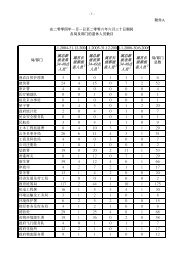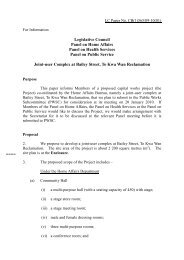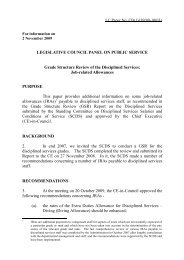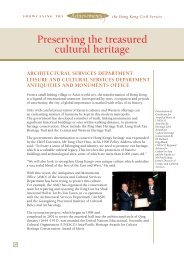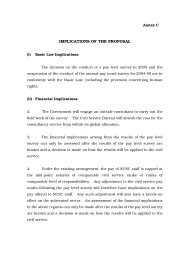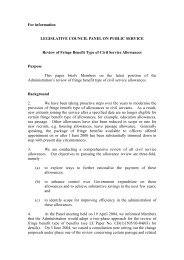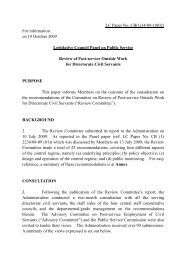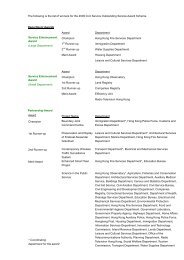Interview with Mr Patrick Chan, BBS, JP Director of ... - å ¬åå¡äºåå±
Interview with Mr Patrick Chan, BBS, JP Director of ... - å ¬åå¡äºåå±
Interview with Mr Patrick Chan, BBS, JP Director of ... - å ¬åå¡äºåå±
- No tags were found...
Create successful ePaper yourself
Turn your PDF publications into a flip-book with our unique Google optimized e-Paper software.
Dissecting the Web:What actually happenswhen youon a hyperlink?14The founding <strong>of</strong> the World Wide Web, an extensivenetwork connecting the entire world, hasfundamentally changed the world. Information,conversations and business transactions are nowtraversing freely from anywhere in the world toanywhere else in the world instantly, unhinderedby geographical constraints.Leveraging this enormous advantage, web-basedIT systems have also been widely deployedin government and businesses to increaseproductivity through connectivity. These days,many government systems embrace a web-baseddesign – using the same technologies as the Web.In a web-based system, the user gains accessthrough a web browser, such as the InternetExplorer. Some examples are the Central CyberGovernment Office (CCGO), and theTreasury Intranet. To further dissectthe Web, this article will explore threefundamental concepts empowering theWeb - how information is transmitted,presented and processed.Transmitting Information –Web FunctioningThe best way to illustrate how theWeb works would be emulating theprocess <strong>of</strong> a user surfing the Web.On the Internet, many web servers are set upto host websites for Internet users, known asclients. The process begins when the clientdecides to access a certain website, such as theGovernment’s website. The first step they take is totype the Uniform Resource Locator (URL) -“www.gov.hk” - into the address box. In doing so,the user directs their own computer to send arequest to the appropriate web server. The requestis then formatted into network packets, whichare basic units <strong>of</strong> information for transmittingsignals over the network, in accordance <strong>with</strong>various protocols. The network packets will bestamped <strong>with</strong> the URL for navigation reference.Now that the data is converted into a transmissionreadyformat, how does the computer knowwhere “www.gov.hk” is? When the request issent out from a computer onto the Web, itarrives at a DNS server for further routing. DNSservers are interconnected servers specialisedin implementing the DNS – a lookup mechanismthat translates the textual URL (www.gov.hk) intoan Internet Protocol (IP) address, a uniqueidentification for a device connected to theInternet. Network packets sent from a computerwould be routed to a DNS server to determine itsdestination based on the IP address. When thestreams <strong>of</strong> packets reach the destination, they aredecoded by the same sets <strong>of</strong> protocols and theWeb server then interprets the request and sendsback the data at www.gov.hk. The data, in anotherstream <strong>of</strong> network packets, will then travel backto the client for display in the users’ web browser.The illustration below briefly outlines the topology<strong>of</strong> the Web and the workflow <strong>of</strong> transmission:1 User wants to go to the website“www.gov.hk”. The computer generatesa request to access www.gov.hk.2 The request is converted intotransmission-ready Networkpackets in accordance <strong>with</strong>the various protocols.Protocols:E.g. HyperTextTransferProtocol(HTTP)DNS Server4 The DNS server matches the phrase“www.gov.hk” <strong>with</strong> the stored IP addressaccording to the Domain Name System.The World Wide Web3 The network packets containing therequest is sent out from the user’scomputer to a DNS Server.5 The request isthen routed to202.128.243.212.DNS Checking:Name:www.gov.hkIP Address:202.128.243.212Content Display –Web Servers and HTMLWeb Server(www.gov.hk)6 The request is then converted backto understandable form by the webserver. The web server processes therequest and returns the webpage tothe user in a similar manner.With the fundamental concept <strong>of</strong> data transmissionover the Web explained, how does the Web enablethe presentation <strong>of</strong> information in such a way thatall computers can consistently comprehend andreplicate it? To begin <strong>with</strong>, you will probably recallthat the Web consists <strong>of</strong> an astronomically largenumber <strong>of</strong> websites. A website is run by a Webserver, which is a computer dedicated to storingall information <strong>of</strong> a website and rendering themaccessible by other users on the Internet. A Webserver has its own IP address to enable accessfrom other computers. It processes any incomingrequests from users and returns the appropriate





